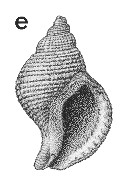
Revised descriptions of New Zealand Cenozoic Mollusca from Beu and Maxwell (1990)

 | Revised descriptions of New Zealand Cenozoic Mollusca from Beu and Maxwell (1990) | 
|
  (Pl. 48e): GS1163, R22/f6498, Kai-Iwi Beach (Kaimatira Pumice Sand?), west of Wanganui, Castlecliffian (GNS) |
Beu & Maxwell (1990): Chapter 16; p. 359; pl. 48 e.
Synonymy: Trophon expansos (sic) Hutton 1882c, p. 278; Trophon expansus Hutton 1883c, p. 410
Classification: Muricidae: Ocenebrinae
Description: Small for family (18-23 mm high), relatively short and wide, with moderately tall spire (slightly shorter than aperture and canal), evenly and gently inflated whorls, short, widely open anterior canal directed to left, no obvious fasciole, and a large oval aperture with lips reflected and lightly to moderately thickened; interior of outer lip bearing a row of low, rounded nodules. Sculpture of low, wide, flat-topped to weakly rounded spiral cords, 4-7 (5 or 6 on most specimens) on spire whorls and about 15 to 20 on last whorl and canal, without obvious shoulder angle or nodules, all rendered weakly and evenly gemmate by many low, closely spaced axial ridges. Protoconch low, dome-shaped, of about 1.5 smooth whorls. Outer lip widely expanded in large specimens.
Comparison: Xymene expansus is a distinctive and biostratigraphically useful species similar to and apparently ancestral to the Castlecliffian-Recent species X. plebeius. It is easily distinguished from X. plebeius by its evenly rounded whorls (few specimens develop the prominent shoulder of X. plebeius) and its more numerous, lower and more closely spaced spiral cords (4-7 on penultimate whorl in X. expansus, 2-3 on X. plebeius). Small shells are weakly inflated and shaped like X. plebeius, but large adults develop a much more strongly expanded outer lip than small shells, and the outer lip interior is only lightly thickened, and bears a row of short transverse ridges. X. expansus was probably restricted to bouldery shores in estuarine and semiestuarine environments (as is X. plebeius now). Beu (2009) reinstated Hutton's (1883) name Xymene drewi for the abundant Nukumaruan shells with lower, closer spiral cords than both X. expansus and X. plebeius, and this in turn apparently was ancestral to X. expansus. Earlier, more coarsely sculptured species are in need of further revision.
Distribution: Late Nukumaruan-early Castlecliffian; Castlecliff, Wanganui, Castlecliffian (type of Trophon expansus); common in very shallow-water, near-shore facies (sand and shellbeds) at Castlecliff, Wanganui (Castlecliffian) and at Nukumaru, Wanganui and in central and southern Hawke's Bay (Nukumaruan).
Cite this publication as: "A.G. Beu and J.I. Raine (2009). Revised
descriptions of New Zealand Cenozoic Mollusca from Beu and Maxwell (1990). GNS
Science miscellaneous series no. 27."
© GNS Science, 2009
ISBN
978-0-478-19705-1
ISSN 1177-2441
(Included with a PDF facsimile file
copy of New Zealand Geological Survey Paleontological Bulletin 58 in CD version
from: Publications Officer, GNS Science, P.O. Box 30368 Lower Hutt, New
Zealand)